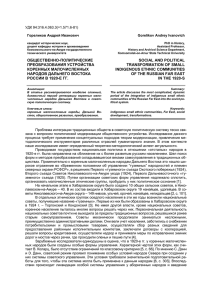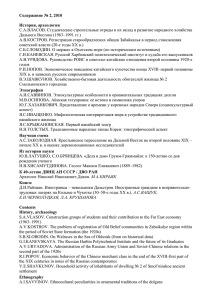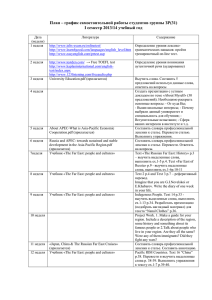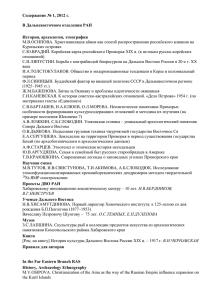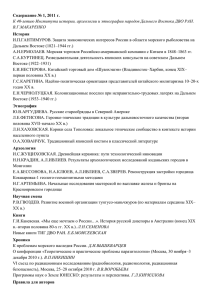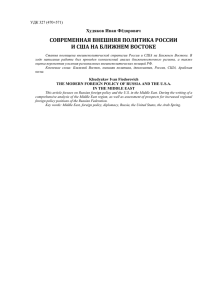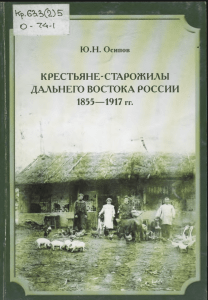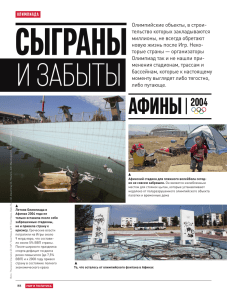2012 N4 - Центральная научная библиотека ДВО РАН
реклама
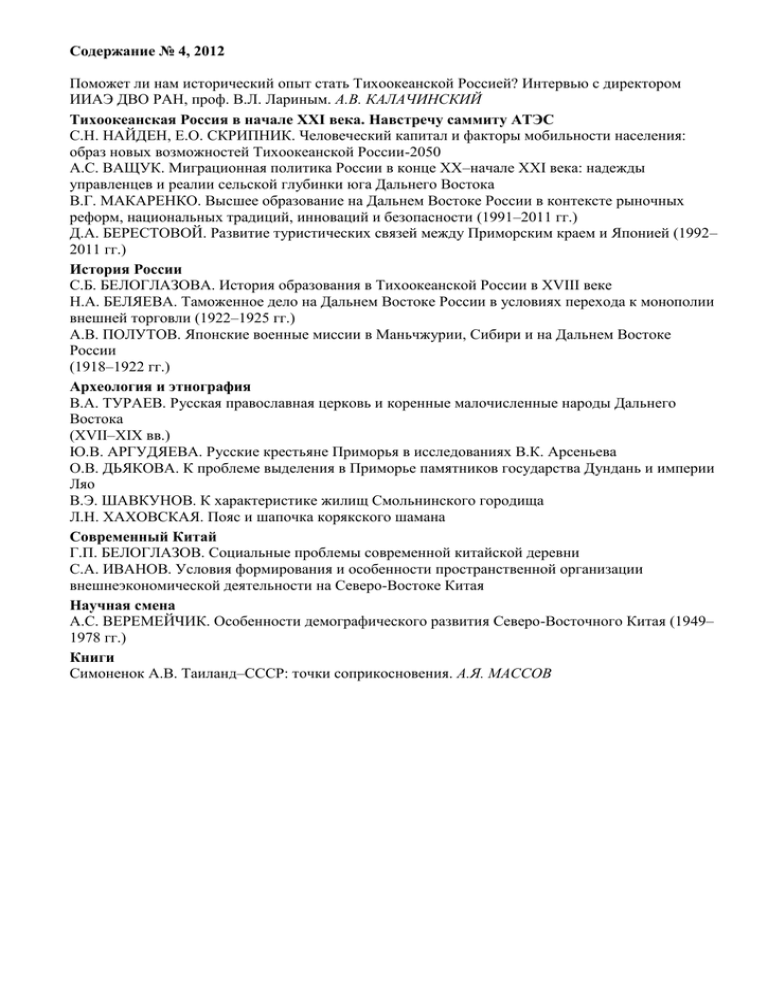
Содержание № 4, 2012 Поможет ли нам исторический опыт стать Тихоокеанской Россией? Интервью с директором ИИАЭ ДВО РАН, проф. В.Л. Лариным. А.В. КАЛАЧИНСКИЙ Тихоокеанская Россия в начале XXI века. Навстречу саммиту АТЭС С.Н. НАЙДЕН, Е.О. СКРИПНИК. Человеческий капитал и факторы мобильности населения: образ новых возможностей Тихоокеанской России-2050 А.С. ВАЩУК. Миграционная политика России в конце ХХ–начале ХХI века: надежды управленцев и реалии сельской глубинки юга Дальнего Востока В.Г. МАКАРЕНКО. Высшее образование на Дальнем Востоке России в контексте рыночных реформ, национальных традиций, инноваций и безопасности (1991–2011 гг.) Д.А. БЕРЕСТОВОЙ. Развитие туристических связей между Приморским краем и Японией (1992– 2011 гг.) История России С.Б. БЕЛОГЛАЗОВА. История образования в Тихоокеанской России в XVIII веке Н.А. БЕЛЯЕВА. Таможенное дело на Дальнем Востоке России в условиях перехода к монополии внешней торговли (1922–1925 гг.) А.В. ПОЛУТОВ. Японские военные миссии в Маньчжурии, Сибири и на Дальнем Востоке России (1918–1922 гг.) Археология и этнография В.А. ТУРАЕВ. Русская православная церковь и коренные малочисленные народы Дальнего Востока (XVII–XIX вв.) Ю.В. АРГУДЯЕВА. Русские крестьяне Приморья в исследованиях В.К. Арсеньева О.В. ДЬЯКОВА. К проблеме выделения в Приморье памятников государства Дундань и империи Ляо В.Э. ШАВКУНОВ. К характеристике жилищ Смольнинского городища Л.Н. ХАХОВСКАЯ. Пояс и шапочка корякского шамана Современный Китай Г.П. БЕЛОГЛАЗОВ. Социальные проблемы современной китайской деревни С.А. ИВАНОВ. Условия формирования и особенности пространственной организации внешнеэкономической деятельности на Северо-Востоке Китая Научная смена А.С. ВЕРЕМЕЙЧИК. Особенности демографического развития Северо-Восточного Китая (1949– 1978 гг.) Книги Симоненок А.В. Таиланд–СССР: точки соприкосновения. А.Я. МАССОВ Contents № 4, 2012 Will our historical experience help us to become the Pacific Russia? Interview with V.L. Larin, Prof., Director of the Institute of History, Archaeology and Ethnography of Peoples of the Far East, FEB RAS. A.V. KALACHINSKY Pacific Russia in the beginning of XXI century. Towards APEC summit S.N. NAYDEN., E.O. SKRIPNIK. Human capital and the factors of people mobility: the image of new possibilities of the Pacific Russia in 2050 A.S. VASCHUK. Migration policy of Russia at the end of the 20th – the early 21st centuries: hopes of officials and the reality of the remote villages of the south of the Far East ... V.G. MAKARENKO. High education of the Far East of Russia in the system of market reforms, national traditions, innovations and security (1991–2011) D.A. BERESTOVOY. Development of tourist links between Primorsky Krai and Japan (1992–2011) History of Russia S.B. BELOGLAZOVA. History of Education in the Pacific Russia in XVIII century N.A.BELYAEVA. Customs service in the Russian Far East in the conditions of passage to the foreign trade monopoly (1922–1925) A.V. POLUTOV. Japanese military missions in Manchuria, Siberia and Russian Far East during 1918– 1922 Archaeology and Ethnography V.A. TURAEV. Russian Orthodox Church and the indigenous peoples of the Far East (XVII–XIX cc.) Yu.V. ARGUDYAEVA. Russian peasants in Primorye: V.K. Arsenyev studies O.V. DIAKOVA. To the problem of distinguishing sites of the Dongdan Kingdom and the Liao Empire in Primorye V.E. SHAVKUNOV. On the dwelling characteristics of Smol’ninskoe walled town L.N. HAHOVSKAYA. Koryak shaman’s belt and cap Modern China G.P. BELOGLAZOV. Social problems of the contemporary Chinese village S.A. IVANOV. Forming Conditions and Features of Spatial Organization of Foreign Economic Activities in the Northeast China New scientific personnel A.S. VEREMEYCHIK. Features of demographic development in the Northeast China (1949–1978) Books Simonenok S.V. Thailand – USSR: common points. A.Ya. MASSOV РЕФЕРАТЫ С.Н. НАЙДЕН, Е.О. СКРИПНИК УДК 331.34 (571.6) Человеческий капитал и факторы мобильности населения: образ новых возможностей Тихоокеанской России-2050 Анализируются прогнозные варианты изменения численности населения Дальнего Востока до 2050 г. и возможные источники миграционных потоков. Рассматриваются потенциальные направления развития транспортной и образовательной систем в восточном регионе России в условиях расширения пространственной мобильности и усиления социальных мотиваций населения. Ключевые слова: прогноз численности населения Дальнего Востока, миграция, пространственная мобильность, социальное развитие, образование. Human capital and the factors of people mobility: the image of new possibilities of the Pacific Russia in 2050. S.N. NAYDEN., E.O. SKRIPNIK (Economic Research Institute, FEB RAS, Khabarovsk). This article analyzes the projected variants of changes in population of the Far East until 2050, and possible sources of migration. It discusses potential direction of development of the transport and educational systems in the Eastern Russia in view of improving of spatial mobility and social motivation of the population. Key words: forecast of population of the Far East, migration, spatial mobility, social development, education. А.С. ВАЩУК УДК 314.727(571.6) Миграционная политика России в конце ХХ–начале ХХI века: надежды управленцев и реалии сельской глубинки юга Дальнего Востока Миграционная политика анализируется автором в рамках исторической концепции «выгоды и проблемы для государства, общества, мигрантов». Выделены 3 направления миграционной политики, имеющие значение для дальневосточного села: переселение корейцев из бывших советских республик, привлечение трудовых мигрантов из дальнего и ближнего зарубежья, реализация программы «Соотечественники». Сравнивается опыт Амурской области и Приморского края в области реализации программы «Соотечественники». Ключевые слова: Дальний Восток, миграционная политика, мигранты, российские корейцы, иностранная рабочая сила, программа «Соотечественники». Migration policy of Russia at the end of the 20th –the early 21st centuries: hopes of officials and the reality of the remote villages of the south of the Far East. A.S. VASCHUK (Institute of History, Archaeology and Ethnography of the Peoples of the Far East, FEB RAS, Vladivostok). The article contains the analysis of migration policy within the historical conception of its «profit and problematical character for state, society and migrants». The author marks out 3 directions of migration policy which are significant for the Far Eastern village: migration of Koreans, arriving from the former Soviet republics, involvement of labor migrants from distant and neighboring abroad and realization of the program «Compatriots». The experience of Amurskaya oblast and Primorsky Krai in the field of realization of the program «Compatriots» is compared. Key words: Far East, migration policy, migrants, Russian Koreans, foreign working power, program «Compatriots». В.Г. МАКАРЕНКО УДК 378.1(09)(571.6) Высшее образование на Дальнем Востоке России в контексте рыночных реформ, национальных традиций, инноваций и безопасности (1991–2011 гг.) Исследован опыт рыночных реформ в системе высшего образования на Дальнем Востоке России в 1991–2011 гг. Ключевые слова: высшее образование, Дальний Восток России, реформы, традиции, инновации, рынок труда, национальная безопасность. High education of the Far East of Russia in the system of market reforms, national traditions, innovations and security (1991–2011). V.G.MAKARENKO (Institute of History, Archaeology and Ethnography of the Peoples of the Far East, FEB RAS, Vladivostok). Market reforms experience in the Russian Far East universities during 1991–2011 was researched. Key words: high education, Far East of Russia, reforms, traditions, innovations, job market, national security. Д.А. БЕРЕСТОВОЙ УДК 796.5(571.63+52) Развитие туристических связей между Приморским краем и Японией (1992–2011 гг.) Анализируются статистические данные по развитию туризма между Приморским краем и Японией. Рассматривается потенциал края по въездному туризму. Ключевые слова: туризм, Приморский край, Япония, туроператоры, «Интурист-Находка», историко-культурные связи. Development of tourist links between Primorsky Krai and Japan (1992–2011). D.A. BERESTOVOY (Institute of History, Archaeology and Ethnography of the Peoples of the Far East, FEB RAS, Vladivostok). Statistical data on the development of tourism between Primorsky Krai and Japan in 1992–2011 are analyzed. The potential of Primorsky Krai in incoming tourism is considered. Key words: tourism, Primorsky Krai, Japan, tour operators, «Intourist-Nakhodka», historical and cultural relations. С.Б. БЕЛОГЛАЗОВА УДК 373/377(5-012+798)(09) История образования в Тихоокеанской России в XVIII веке Исследованы малоизученные в региональной историографии вопросы истории развития образования на восточных окраинах России в период модернизации страны в XVIII в. Ключевые слова: горнозаводские и навигацкие школы, общее образование, реформа образования, Якутия, Забайкалье, Камчатка, Охотск, Русская Америка. History of Education in the Pacific the Russia in XVIII century. S.B. BELOGLAZOVA (Institute of History, Archaeology and Ethnography of Peoples of the Far East, FEB RAS, Vladivostok). Insufficiently explored issues in regional historiography of history of development of education in eastern edge of Russia during the country modernization in XVIII century were studied. Key words: mining and smelting schools, navigation schools, general education, reform of education, Yakutiya, Transbaicalye, Kamchatka, Ohotsck, Russian America. Н.А. БЕЛЯЕВА УДК 94(571).084.3 Таможенное дело на Дальнем Востоке России в условиях перехода к монополии внешней торговли (1922–1925 гг.) Рассматриваются основные направления перестройки таможенных учреждений Дальнего Востока после завершения Гражданской войны в условиях распространения на окраину государственной монополии внешней торговли. Ключевые слова: советская власть, восстановление экономики, таможенные учреждения, внешняя торговля, государственная монополия, лицензионная политика. Customs service in the Russian Far East in the conditions of passage to the foreign trade monopoly (1922–1925). N.A. BELYAEVA (Vladivostok branch of the Russian Customs Academy, VB RCA, Vladivostok). The author dwells upon the main changes in customs service structure of the Russian Far East after the Civil war when the state monopoly of foreign trade reached the region. Key words: the Soviet power, economic recovery, customs organizations, foreign trade, state monopoly, licensing policy. А.В. ПОЛУТОВ УДК 952.033.3 Японские военные миссии в Маньчжурии, Сибири и на Дальнем Востоке России (1918–1922 гг.) На основе японских архивных документов, большинство из которых впервые публикуется в России, анализируется деятельность специальных органов военной разведки Японии (японских военных миссий) в Маньчжурии, Сибири и на Дальнем Востоке России во время Гражданской войны и иностранной интервенции в 1918–1922 гг. Ключевые слова: Россия, Япония, военная разведка, «токуму кикан» – японская военная миссия, Маньчжурия, Сибирь, Дальний Восток России, Гражданская война, иностранная интервенция. Japanese military missions in Manchuria, Siberia and Russian Far East during 1918–1922. A.V. POLUTOV (Institute of History, Archaeology and Ethnography of the Peoples of the Far East, FEB RAS, Vladivostok). The paper reveals the activities of the Special intelligence service of the Japanese Army (Japanese military missions) in Manchuria, Siberia and Russian Far East during the Civil War and foreign intervention in 1918–1922. Key words: Russia, Japan, military intelligence, «tokumu kikan» – Japanese military missions, Manchuria, Siberia, Far East, the Civil War, foreign intervention. В.А. ТУРАЕВ УДК 281.9+397(571.6) Русская православная церковь и коренные малочисленные народы Дальнего Востока (XVII–XIX вв.) Рассматривается процесс христианизации коренных малочисленных народов Дальнего Востока в ХVII–ХIХ вв., показаны воздействие христианства на этнические процессы, социокультурные аспекты христианизации. Ключевые слова: коренные малочисленные народы Дальнего Востока, христианизация, православие как инструмент русификации, социокультурные аспекты христианизации. Russian Orthodox Church and the indigenous peoples of the Far East (XVII–XIX cc.). V.A. TURAEV (Institute of History, Archaeology and Ethnography of the Peoples of the Far East, FEB RAS, Vladivostok). The process of Christianization of the indigenous peoples of the Far East in the 17th and 19th centuries is considered. The impact of Christianity on ethnic processes and socio-cultural aspects of the conversion to Christianity are shown. Keywords: indigenous peoples of the Far East, Christianization, Orthodoxy as a tool of Russification, sociocultural aspects of the Christianization. Ю.В. АРГУДЯЕВА УДК 947.083.2(571.6)+390 (=82) Русские крестьяне Приморья в исследованиях В.К. Арсеньева Статья основана на материалах экспедиционных исследований В.К. Арсеньева и, частично, государственных архивов Дальнего Востока и Иркутской области. Обращено внимание на обширность этнографических наблюдений Арсеньева. Дана краткая история появления во второй половине ХIХ в. первых русских крестьян на приамурской и приморской земле. Охарактеризован процесс их переселения, образования первых русских деревень. Рассматриваются особенности и сложности адаптации в Приморье двух групп русских крестьян – приверженцев официально признанного православия и старообрядцев. Объяснены причины вынужденной смены традиционных занятий другими видами хозяйственной деятельности. Приведены дневниковые записи В.К. Арсеньева, характеризующие особенности жизнедеятельности первых русских крестьян на приморской земле. Ключевые слова: В.К. Арсеньев, Приморье, русские крестьяне, старообрядцы, переселение, адаптация, русские традиции, смена традиционных занятий. Russian peasants in Primorye: V.K. Arsenyev studies. Yu.V. ARGUDYAEVA (Institute of History, Archaeology and Ethnography of the Peoples of the Far East, FEB RAS, Vladivostok). The article is based mainly on the expedition materials by V.K. Arsenyev and partly on the materials of state archives of the Far East and Irkutsk oblast. It is important to point out the breadth and variety of scholarly interests of a famous Far Eastern explorer V.K. Arsenyev. The author gives a brief historical account of arrival of the first Russian peasants to Priamurye and Primorye in the second half of the 19th century. There is analyzed the process of their relocation and appearance of the first Russian villages. The author describes peculiarities and obstacles that two groups of Russian peasants – adherents of Orthodoxy and old-believers – encountered during the adaptation in Primorye. There are found explanations of forced alterations in traditional economic structure in favor of the other trades. There are published excerpts from V.K. Arsenyev’s diaries describing peculiarities of the first Russian peasants’ life in Primorye. Key words: V.K. Arsenyev, Primorye, Russian peasants, old-believers, resettlement, adaptation, Russian traditions, change of traditional occupations. О.В. ДЬЯКОВА УДК 930.26 (518+571.63) К проблеме выделения в Приморье памятников государства Дундань и империи Ляо Впервые выделены археологические памятники эпохи государства Дундань (Восточное Кидань) в Приморье, являющегося белым пятном в истории Дальнего Востока. Ключевые слова: Бохай, кидани, Приморье, чжурчжэни, Когурё, мохэсцы, фортификация, Дундань. To the problem of distinguishing sites of the Dongdan Kingdom and the Liao Empire in Primorye. O.V. DIAKOVA (Institute of History, Archaeology and Ethnography of the Peoples of the Far East, FEB RAS, Vladivostok). For the first time the article distinguishes archaeological sites of the epoch of the Dongdan Kingdom (Eastern Khitan) in Primorye that is a blind-spot in the history of the Far East. Key words: Balhae, Khitan, Primorye, the Jurchens, Goguryeo, Mohe people, fortification, Dongdan. В.Э. ШАВКУНОВ УДК 930.26 (571.63) К характеристике жилищ Смольнинского городища В статье описаны жилища, раскопанные автором на Смольнинском городище. Выявлены как общие черты, так и различия в их устройстве. Проводится сравнение смольнинских жилищ с жилищами других археологических культур на территории Приморского края. Делается вывод о том, что во второй половине I тысячелетия н.э. в регионе идет процесс поиска наиболее эффективных и в то же время простых отопительных систем типа кана. Ключевые слова: археология, смольнинская культура, жилища. On the dwelling characteristics of Smol’ninskoe walled town. V.E. SHAVKUNOV (Institute of History, Archaeology and Ethnography of the Peoples of the Far East, FEB RAS, Vladivostok). The article analyses dwellings that the author excavated in Smol’ninskoe walled town. Both common points and differences in their construction are revealed. There is a comparison of Smol’ninskoe dwellings and dwellings of the other cultures of Primorskii krai. The author comes to the conclusion that at the second part of the 1st thousand A.D., there took place a process of searching the most effective and at the same time the most simple heating systems of kan type. Key words: archaeology, Smol’ninskaya culture, dwellings. Л.Н. ХАХОВСКАЯ УДК 391.4(571.65) Пояс и шапочка корякского шамана На основании полевых материалов автора исследованы два элемента облачения корякского шамана – пояс и шапочка. Выделены три типа шаманских головных уборов коряков (обруч, венец, капор). Выявлен полный комплекс декоративных украшений корякских ритуальных головных уборов, которые предложено считать сакральными «метками», маркирующими естественные отверстия на шкуре головы животного. Подчеркнуто значение меток, обозначающих «органы зрения»: вследствие имитативного и поведенческого переноса они могут быть представлены не только на головных уборах, но и на поясе корякского шамана. Ключевые слова: коряки, село Верхний Парень, Северо-Эвенский район, Магаданская область, шаманский пояс, шаманская шапочка, типы шаманских шапок коряков, сакральные метки. Koryak shaman’s belt and cap. L.N.HAHOVSKAYA (The North-East Interdisciplinary Scientific Research Institute, Magadan). Based on the field materials the description of the two things (belt and cap) that belonged to the Koryak shaman is represented. Three basic types of the Koryak shaman headgear: hoop, crown and hood are selected. Has been identified the full complex of Koryak ritual headgear, suggested to consider the sacred nodding «labels», which mark the orifices on the skin of the animal’s head. The special emphasis has been laid on the complex of “the visual organs”: due to imitative and behavioural transference they may be represented not only in the decoration of the headgear but also in the described shaman belt. Key words: the Koryak, Verchni Paren village, Severo-Evensk area, Magadan region, the shaman’s belt, the shaman`s cap, the types of Koryak shaman`s cap, the sacred markings. Г.П. БЕЛОГЛАЗОВ УДК 951.098:323.333 Социальные проблемы современной китайской деревни Рассматриваются кризисные явления системного характера в агропромышленном комплексе КНР в начале XXI в. Отмечается, что отрасль, исчерпав первоначальный потенциал, вступила в период стагнации, и это обусловило социальную напряженность в деревне, создающую угрозу политической стабильности государства. Ключевые слова: Китай, аграрный комплекс, стагнация, социальные проблемы. Social problems of the contemporary Chinese village. G.P. BELOGLAZOV (Institute of History, Archaeology and Ethnography of the Peoples of the Far East, FEB RAS, Vladivostok). The system-oriented crisis developments in the agricultural complex of China in the early 21st century are considered. The agrarian sector has entered a period of stagnation, having exhausted the initial potential, having pre-conditioned the social tensions in the country, which threatens the political stability of the state. Key words: China, the agricultural complex, stagnation, social problems. С.А. ИВАНОВ УДК 327 (511) Условия формирования и особенности пространственной организации внешнеэкономической деятельности на Северо-Востоке Китая Рассматриваются условия развития и современное состояние пространственной организации международных экономических связей Северо-Восточного Китая. Анализ особенностей дифференциации пространства северо-восточных провинций Китая с точки зрения внешнеэкономической деятельности позволяет переосмыслить текущее состояние и потенциал экономического сотрудничества Северо-Востока КНР с Дальним Востоком РФ, а также перспективы интеграции этих территорий. Ключевые слова: внешнеэкономическая деятельность, Северо-Восток Китая, пространственная организация, приграничное сотрудничество, международная торговля, иностранные инвестиции. Forming Conditions and Features of Spatial Organization of Foreign Economic Activities in Northeast China. S.A. IVANOV (Institute of History, Archeology and Ethnography of the Peoples of Far East, FEB RAS, Vladivostok). The article examines historical conditions of formation and current state of international economic ties of Northeast China. The analysis of spatial organization of foreign economic activities of China’s northeastern provinces helps to take a fresh look on the current state and potential of cross-border and interregional cooperation between Northeast China and Russian Far East, as well as prospects of their integration. Key words: foreign economic activity, Northeast China, spatial organization, cross-border cooperation, international trade, foreign investments. А.С. ВЕРЕМЕЙЧИК УДК 314,1 (511) Особенности демографического развития Северо-Восточного Китая (1949–1978 гг.) Рассматриваются особенности демографического развития Северо-Восточного Китая в 1949–1978 гг., в том числе изменения, произошедшие под влиянием социально-экономических факторов и политики народонаселения. Показано, каким образом специфика освоения этой части Китая отразилась на последующем развитии демографических процессов в регионе. Ключевые слова: Северо-Восточный Китай, демографическое развитие, воспроизводство населения, миграционные процессы, политика народонаселения. Features of demographic development in the Northeast China (1949–1978). A.S. VEREMEYCHIK (Institute of History, Archaeology and Ethnography of the Peoples of the Far East, FEB RAS, Vladivostok). This article discusses the demographic characteristics of the Northeast China during the period 1949–1978’s., the changes that have occurred under the influence of socio-economic factors and population policy. It is shown how the specific of the development of the North-East was reflected in the subsequent processes of population reproduction in the region. Key words: Northeast China, demographic development, population reproduction, migration processes, population policy.
